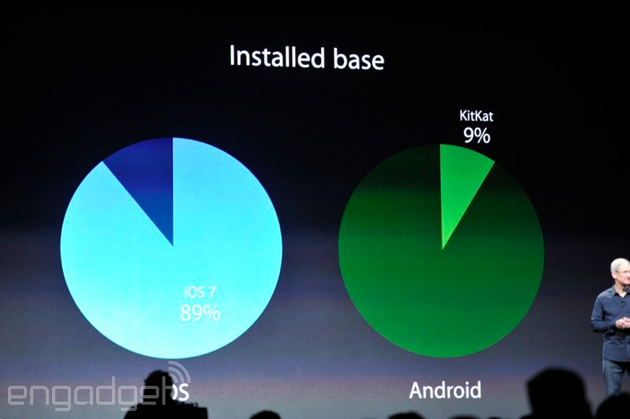
Charts, graphs and stats: These are the things Apple keynotes are made of, and today’s WWDC 2014 kickoff was no different. CEO Tim Cook took to the stage this morning at the Moscone Center in San Francisco armed with enough numerical ammunition to put your best boardroom PowerPoint Keynote to shame. Cook kicked things off boasting that over 40 million copies of OS X Mavericks have been installed and more than 50 percent of the install base is working on its latest OS. He went on to point out that while PC sales continued to slip (down 5 percent, according to Cook), Apple’s computer sales are growing.
However, according to Gartner’s Q1 2014 shipment estimates, Apple failed to crack the top five in worldwide shipments, coming in at number three in the US with 10.8 percent of the market.
In the OS wars, Apple may have strong adoption for its latest, but OS X still trails Windows by a large margin. Microsoft’s Windows 8 (released in late 2012) reached 200 million licenses by February of this year. While we don’t have internal numbers on its latest update, Windows 8.1 (released in October 2013) surpassed both Apple’s OS X 10.9 Mavericks and Microsoft’s own Windows 8 with 6.35 percent of the market according to May 2014 stats from Net Applications. Meanwhile, that same report pegs Windows 7 at 50 percent of the OS market. Regardless of its growth and reach, Apple is still a distant second in the race for desktop dominance.

And in the smartphone market, Android still holds the title. According to Strategy Analytics, Apple’s mobile OS reached 15.5 percent of the market in 2013, down from 19.4 percent the year before, with Android hitting 78.9 percent, up from 68.8 percent in 2012. Despite those numbers, Cook mocked the competing operating system’s fragmentation issues, saying 98 percent of iOS users are now on iOS 7, while only 9 percent (8.5 percent according to Google) of Android users are now on its latest OS, KitKat.
According to Cook, a 97 percent customer satisfaction rating shows why it’s had 130 million new iOS users in the last year and half of its Chinese customers switching from Android to iPhone in the last six months. To be fair, the iPhone just reached that country’s largest carrier, China Mobile, in January. As Cook not-so-lightly put it:
“They bought an Android phone, by mistake, then sought a better experience, and life.”
Taking a step back and looking at the big picture, Cook boasted a total of 800 million iOS devices shipped. Back in June of last year, that number was 600 million, up from 500 million in January 2013. The iPhone, which launched in 2007, has since reached 500 million units shipped. Samsung, Apple’s biggest mobile rival, meanwhile, announced it sold 200 million Galaxy S smartphones (launched in 2010) as of February. So where does the rest of that 800 million come from? Apparently, Apple’s shipped 100 million total iPod Touches and 200 million iPads.
At this rate, we wouldn’t be shocked to hear Cook boasting iOS billions some time next year. In the meantime, Apple has more than just billions in profits to gloat about. As of today, users have downloaded 75 billion apps from the App Store, with 1.2 million apps to choose from and 300 million visits to the digital storefront every week.
As of June 2013, Google boasted 900 million Android activations to date, with more than 1 million apps in the Play Store and 50 billion app downloads. While Apple continues to come in a far second to Google in OS market share, it’s clear that its app ecosystem is a strong draw for users.
In the end, Apple may not have the dominant OS in either arena, but it still has plenty to brag about.
Filed under: Cellphones, Desktops, Laptops, Software, Mobile, Apple
Comments

